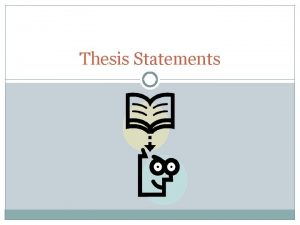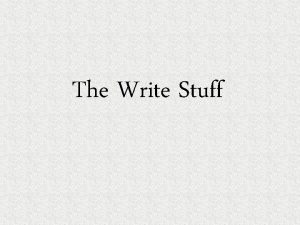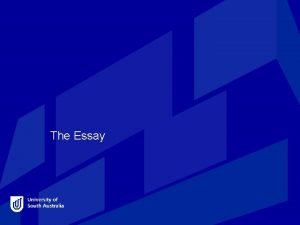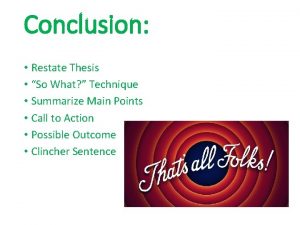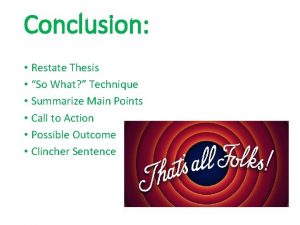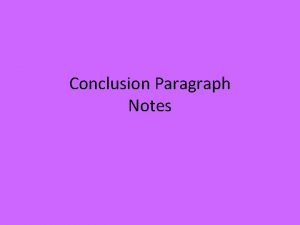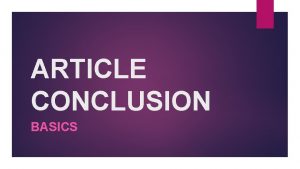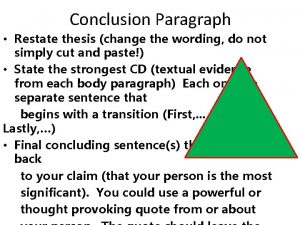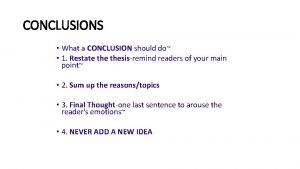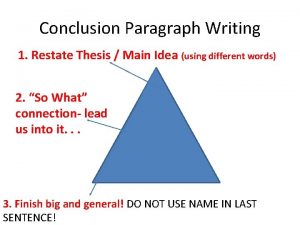How to write a GOOD conclusion GREAT Restate








- Slides: 8

How to write a GOOD conclusion… GREAT

Re-state the Question/Problem Statement • Examples: 1. In science class, we performed an experiment to find out if our reaction time was quickest using our sense of sight, sound, or touch…. 2. In science class, we tested our reaction time using our sense of sight, sound, and touch to see which of our senses had the fastest reaction time

Re-state your hypothesis…. • Example: • I thought that if I used my sense of sight in the lab, then I would have a faster reaction time than I would with touch or sound.

Brief explanation of procedure… • To test my hypothesis and to find an answer to our question, we performed a lab to test reaction time. We had one person drop a ruler, and the other catch it. The longer it took the person to catch the ruler, the higher their hand would grasp on the ruler (the greater the distance the ruler traveled). We first tested sight. Then tested touch by having the catcher close their eyes. The person dropping the ruler then dropped the ruler and tapped the catcher on the shoulder simultaneously. Lastly, we tested sound by having the catcher close their eyes, and the person dropping to ruler saying “now” as they let the ruler go. We performed 5 trials for each sense and then found the average to see which sense resulted in the fastest reaction time.

Hypothesis- right or wrong? Prove it! • This should be the “meat” of your conclusion! – According to my data, my hypothesis was wrong. The sense I reacted most quickly with was sound. The average distance the ruler traveled when using my sense of sight to catch it for 5 trials was 17. 2 cm. The average distance the ruler traveled when using my sense of sound to catch it for 5 trials was only 12. 1 cm. My slowest reactions occurred when using sense of touch. My average at the end of 5 trials for touch was 22. 6 cm. Even though 3 of my individual trials for sight and touch were quicker than 1 of my trials for sound, on average my quickest reaction time came with sense of sound.

Data Analysis Make sense of your data…. What does it tell you? – When looking at my data, all of my trials are pretty close. In fact, all trials fell between 15 -23 cm. – My fastest trial out of all three senses actually occurred in my 3 rd trial for sight, 15. 1 cm. This makes me wonder how accurate my data is, because sound ended up being my fastest average. I guess this is why we performed multiple trials.

Any problems? • If I were to test my hypothesis a second time, I would perform more trials for each sense. I would probably use 10 -15 trials, then find the average. • I think inaccuracies can occur with the person dropping the ruler. They could say “now” too early or late. They could touch the catcher too early or late. • I think inaccuracies can occur with the catcher as well. They could have their fingers too close together and the ruler could get stuck on their hand, stopping the ruler from dropping.

Concluding statement… All in all, our experiment to test the reaction speed of the senses sight, sound, and touch went pretty well. My hypothesis was incorrect, my fastest reaction time was achieved when using my sense of sound, but my results were pretty close. I would be interested to test my hypothesis again using a different method to measure reaction speed.
